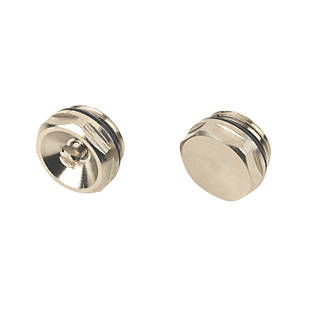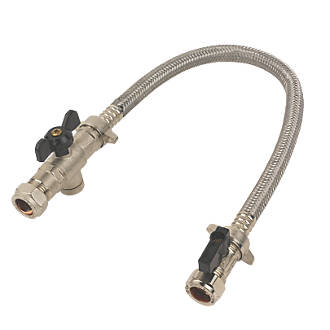How to bleed a radiator

Our expert engineer with years of experience in the industry will guide you through how to bleed a radiator in your home and avoid corrosion and save money on your heating bills.
Check your heating system every few months if needs bleeding radiators. Installing a magnetic filter and pouring inhibitors in the system can decrease corrosion and unwanted air buildup in the heating system.
Why do you need to bleed a radiator?
Bleeding radiators will help the boiler and the heating system perform better. It’s a very common problem in an unvented heating system when you have a heat-only boiler.
All the trapped air in the system creates cold spots and the radiators stopping the water circulation. Also, a lot of air in the system can cause central heating pump cavitation, which will lead to pump failure. Trapped air inside the system can cause corrosion too.
The Radiator at the top is cold
For us engineers, it is easy to check with a thermal camera what is the issue.
The most common sign is when it’s time to bleed radiators is when the top side is cold. The air trapped inside in the top of the radiator stoping the heating system water circulation and also showing cold spots on the radiators.
To bleed out the radiator is very easy, but you have to be careful not to splash the dirty water everywhere. If you will release the air from the system and you don’t have any other issues, your heating system will work again.
The whole radiator is cold
This is not a common sign of air in the system. If the entire radiator is cold, you could have problems with the central heating circulation.
Here are the reasons why the entire radiator is cold:
- You can have sludge build-up in the bottom of the radiator, blocking the water flow.
- Your thermostatic radiator valves are faulty or blocked and no flow will come through the radiator.
- You could have a faulty central heating pump or diverter valve depends what boiler and system you have.
- It can be heating system faults that are not opening the diverter, motorized valve.
- If your system doesn’t have a magnetic filter, high corrosion can lead to underperformed radiators.
As you see many faulty parts can cause radiator blockage.
If you are struggling to find a solution for your heating system repair, find an engineer who will help you resolve your problem.
Radiator rattling noise
Trapped air in the heating system can cause your radiator to rattle and giving out gurgling noises. Your pipework can be noisy too. All you have to do is to bleed out the radiators and you might sort out the issues.
Tools you need to bleed out the radiators
- Radiator key
- Sometimes a flat head screwdriver.
- A pipe wrench, to hold that bleed valve if it’s turning.
- Old towel or toilet paper or a bucket to catch the water.
- Gloves, sometimes there is dirty water in the radiators.
Top tips: Don’t burn yourself! If you heat the system the water in the radiator can be more than 60 degrees.
Steps to bleed the radiators
Follow our step by step guide to bleed out your radiators and avoid mistakes.
Before you start the work, don’t forget to open the radiator thermostatic valves and lockshield valves. Als take off the thermostatic valve head and check the valve pin if it isn’t stuck. If the pin is stuck, you can get a spanner and try to pull up 1-2 millimetres. Don’t pull out the pin too much because if it coming out, you end up with a fountain in the bedroom.
This pin is controlling the flow into the radiators.
We normally just push down the pin, and if it’s moving easily then it’s working properly.
Key tips: When you bleeding radiators, the boiler pressure will drop (if you have a sealed combi or system boiler). All you have to do is to start to top up the system to 1 bar when it’s dropped. When you fill your system, do it slowly to avoid too much air getting in the system. With cold water, you also introduce more air to the radiators.
Open vented system will top-up automatically.
Bleeding a radiator when it’s cold
First, bleed your radiators when they are cold. Start with the downstairs radiators first. If the radiator bleed valve is turning while you open the small pin, you have to hold the valve with a pipe wrench.
Turn your heating on
After you heat your central heating system, again you start at the downstairs radiators. When the central heating system is warm the air from the cold water will dissipate. Also, the hot water will expand, creating pressure in the system and it will help bleed the radiators.
Check which radiators need bleeding
Identify the cold patches on the radiators. But we recommend bleeding out all your radiators in your home!
Switch off your central heating system
You turn off your heating system to avoid too much water coming out from the radiators. Also, you can avoid the central heating pump running dry causing cavitation.
Before you start bleeding the radiators
Get a towel and a small bucket under the bleed valve. Put it very close to the bleed valve so not one drop of dirty water can go to your white carpet. Also, think about emergencies! If your bleed valve came off, get ready to close both sides of the radiator valves.
Open the radiator bleed valve with a bleed key

Put the radiator bleed key (or flat head screwdriver) into the bleed valve. The pin that you have to turn is a small square nipple (screw). You have to turn the bleed valve anticlockwise slowly and release the air from the system. Sometimes when air escapes it comes out smelly, this is a sign of corrosion in the system. You can smell the hydrogen build up in the radiators, which is a product of corrosion.
Hold open the bleed valve

Just open the valve slowly turning it anticlockwise till you hear the hissing sound. Do not turn the pin fully out, anyway all the water will go to the floor. There are high water pressure in the radiators, if the pin comes out it will be hard to put back.
Hold the valve open till the water will come out from the radiators. Now you completed the radiator bleeding. Turn back the radiator screw but don’t overtighten. Now all the air is released from the system and you can go to the other radiator.
Top up the pressure in the central heating system

After you finished the radiator bleeding, you have to top up the pressure in the system.
First, you have to find the pressure gauge, which can be on the boiler or next to the expansion tank, if you have a vented system.
The boiler pressure needs to be 1-1.2 Bar. You find the filling loop in the combi boiler, which is a flexible pipe with both ends an isolation valve. You have to fully open both valves slowly and start to top up the system. If you overpressurised the system, you just go to one of the radiators and bleed out the water. This will decrease the pressure in the system.
How to run your system energy efficient
Keeping the system clean by installing a magnetic filter, also using an inhibitor for system protection. You can book a central heating system wash also upgrading your radiator valves for a newer one. All these steps making sure you have a fully working energy-efficient heating system.
Don’t run the radiators at number 5 (in the radiator thermostatic valve) in the room that you are not using and save money on your energy bills.
Just to know bleeding a radiator doesn’t mean you cleaning the heating system. If you need a system clean, you need to book a power flush or system clean wash. For cleaning, the central heating system needs to be drained, filled and washed properly and inspecting all the radiators one by one.
Hope all of the above information will help you to diagnose what is the issue in your heating system.
Did you manage to bleed out all your radiators? Are they still cold? For fault diagnosis, you can contact MML Plumbing and we can book you a fully registered gas safe engineer who can fix your radiator problems!
Frequently asked questions about bleeding a radiator
Q: Do You Bleed Your Radiators With The Heating On Or Off?
You should bleed the radiators when it’s cold and then after it is heated up.
Q: Which Radiators Do You Bleed First?
You start with the bottom radiators first.
Q: How Long Should It Take To Bleed A Radiator?
It can take just 15-40 seconds. But in some cases, it can take up to 2 minutes.
Q: Should water come out when you bleed a radiator?
After you bleed the radiators, there will be some water drops. That is totally fine.
Q: Why is 1 radiator in my house cold?
The radiator valve is stuck or the radiators are not balanced properly.
Q: Can you bleed a radiator without a radiator key?
You can use a flathead screwdriver instead of a radiator bleed key.
Q: Why is the water black when I bleed my radiator?
Few black water drips are totally fine. If you bleed the radiators and even after 2 minutes just black waters coming out, you need a system cleaning.
Q: Why do I keep getting air in my radiators?
Air increases in the radiators by always topping up the system and having a corroded system.
Q: Should you top up the boiler after bleeding the radiator?
Yes. You should always repressurise the boiler to 1-1.2 bar after every radiator bleed.
Q: How do you fix a clogged radiator?
You need a system clean or a power flush.
Q: Why would a radiator suddenly stop working?
If only one radiator is cold, the issue can be sludge in the system or the radiator valves are blocked.
Q: What do you do when one radiator is cold?
First, you have to bleed the radiators, check that radiator valves are working properly and balance the system.
Q: Why is my radiator cold at the bottom of New radiators?
Doesn’t matter if your radiators are now or old, if the bottom part is cold you have a blockage and you need a system cleaning.
DO NEED A PLUMBER?
If you need a plumber who can fix your heating problem, contact us today and we will book you a professional plumber or gas engineer.
The post How to bleed a radiator appeared first on MML Plumbing Ltd.
from MML Plumbing Ltd https://ift.tt/3xmQV8a
via IFTTT
